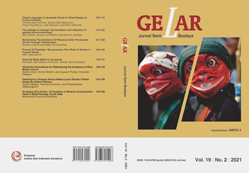Maintaining the Existence of Wayang Golek Punakawan Sunda through Photography
Main Article Content
Abstract
Wayang Golek is one of the nation's cultural heritage that grows and develops in West Java, and its existence still exists today but is starting to decline. Photography is one part of the technology that can bridge the Punakawan Sundanese Wayang Golek Culture in maintaining its existence. The purpose of the research is to maintain the existence of the Punakawan Sundanese Wayang Golek Culture through the media of Photography. The research method uses a qualitative descriptive approach obtained through interviews, observations and is equipped with photographic works. The results of this study indicate that Photography can be one of the media in maintaining the existence of Wayang Golek, especially the Sundanese Punakawan group, through social media such as Instagram. Photography by researchers and other artists' works shared via Instagram can be spread worldwide and stored forever, with periodic and continuous stages, the existence of Wayang Golek, especially Punakawan Sundanese, will be maintained.
Keywords: Art Fotografi; Punakawan;Culture Wayang Golek.
Downloads
Article Details
Copyright
Authors who publish with Gelar: Jurnal Seni Budaya agrees to the following terms:
- Authors retain copyright and grant the journal right of first publication with the work simultaneously licensed under a Creative Commons Attribution License (CC BY-SA 4.0) that allows others to share the work with an acknowledgment of the work's authorship and initial publication in this journal.
- Authors are able to enter into separate, additional contractual arrangements for the non-exclusive distribution of the journal's published version of the work (e.g., post it to an institutional repository or publish it in a book), with an acknowledgment of its initial publication in this journal.
- Authors are permitted and encouraged to post their work online (e.g., in institutional repositories or on their website) prior to and during the submission process, as it can lead to productive exchanges, as well as earlier and greater citation of published work.
References
Ali, Irshad, Sumit Lodhia, and Anil K Narayan. 2020. “Value Creation Attempts via Photographs in Sustainability Reporting: A Legitimacy Theory Perspective.” Meditari Accountancy Research.
Azis, Abdul, Kokom Komalasari, and Iim Siti Masyitoh. 2020. “Strengthening Young Generation Characters In The Disruption Era Through The Internalization of Wayang Golek Values.” Sosiohumaniora 22 (3): 356–64.
Bordo, Susan. 2020. “Introduction: Feminism, Western Culture, and the Body.” In Unbearable Weight, 1–42. University of California Press.
Brodsky, David. 2021. “2.2.‘Learned’ Greek Words.” In Spanish Vocabulary, 70–90. University of Texas Press.
Creese, Helen. 2001. “Old Javanese Studies: A Review of the Field.” Bijdragen Tot de Taal-, Land-En Volkenkunde 157 (1): 3–33.
Farzai, Sara, Mirsaeid Hosseini Shirvani, and Mohsen Rabbani. 2020. “Multi-Objective Communication-Aware Optimization for Virtual Machine Placement in Cloud Datacenters.” Sustainable Computing: Informatics and Systems 28: 100374.
Foley, Kathy. 2021. “Searching for Wayang Golek: Islamic Rod Puppets and Chinese Woodwork in Java.” International Journal of Wood Culture 1 (aop): 1–22.
Friedman, Jonathan. 1990. “Being in the World: Globalization and Localization.” Theory, Culture & Society 7 (2–3): 311–28.
Gunawan, Iwan. 2020. “The Transformation of Ra Kosasih’s Mahabharata Wayang Comics Design: Comparison of the 1955 Version With the 1975 Version.” International Review of Humanities Studies 5 (1).
Halimah, Leli, Robandi R M Arifin, Margaretha S Yuliariatiningsih, Fauzi Abdillah, and Ai Sutini. 2020. “Storytelling through ‘Wayang Golek’ Puppet Show: Practical Ways in Incorporating Character Education in Early Childhood.” Cogent Education 7 (1): 1794495.
Magnis-Suseno, Franz. 2020. “Philosophy, A Challenge To Post-Truth, Also in Indonesia.” Jurnal Filsafat 30 (1): 1–22.
Marcus, George E. 2021. “Introduction: Anthropology on the Move.” In Ethnography through Thick and Thin, 1–30. Princeton University Press.
Nieto Fernandez, Fernando, and Rosana Rubio Hernandez. 2021. “Loneliness in Place.”
Stephens, Jennie C, Maria E Hernandez, Mikael Román, Amanda C Graham, and Roland W Scholz. 2008. “Higher Education as a Change Agent for Sustainability in Different Cultures and Contexts.” International Journal of Sustainability in Higher Education.
Susiani, Ketut. 2021. “Maintenance Efforts of Bali Culture and Language Through Local Content in Primary Schools.” Bisma The Journal of Counseling 5 (1): 9–15.
Tomaž, Kolar, and Wattanacharoensil Walanchalee. 2020. “One Does Not Simply… Project a Destination Image within a Participatory Culture.” Journal of Destination Marketing & Management 18: 100494.
